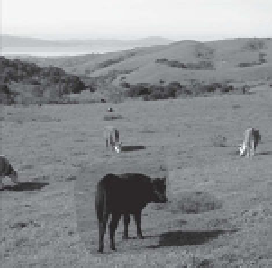Graphics Reference
In-Depth Information
Target
Source
1
0
Target side
Transition region
Source side
Figure 3.2.
The composite contains a weighted average of source and target pixels across the
transition region.
(a)
(b)
(c)
Figure 3.3.
Possible compositing strategies illustrating source weights (top) and composites
(bottom). (a) A hard seam produces a visible, distracting edge. (b) A narrow, linearly-weighted
transition region still creates a visible seam. (c) A wider, linearly-weighted transition region can
result in low-detail regions around the boundary where the two images are averaged, resulting
in a diffuse “halo.”
from Section
2.8.2
, since we're effectively creating a non-binary alpha matte for the
source based on a hard foreground segmentation.
However, deciding on thewidthof the transition region (that is, the region inwhich
pixels are a mix between source and target) is difficult. If the region is too narrow, the
seam will still be visible, but if the region is too wide, the averaging in the transition
region will remove details, as illustrated in Figure
3.3
b-c.













